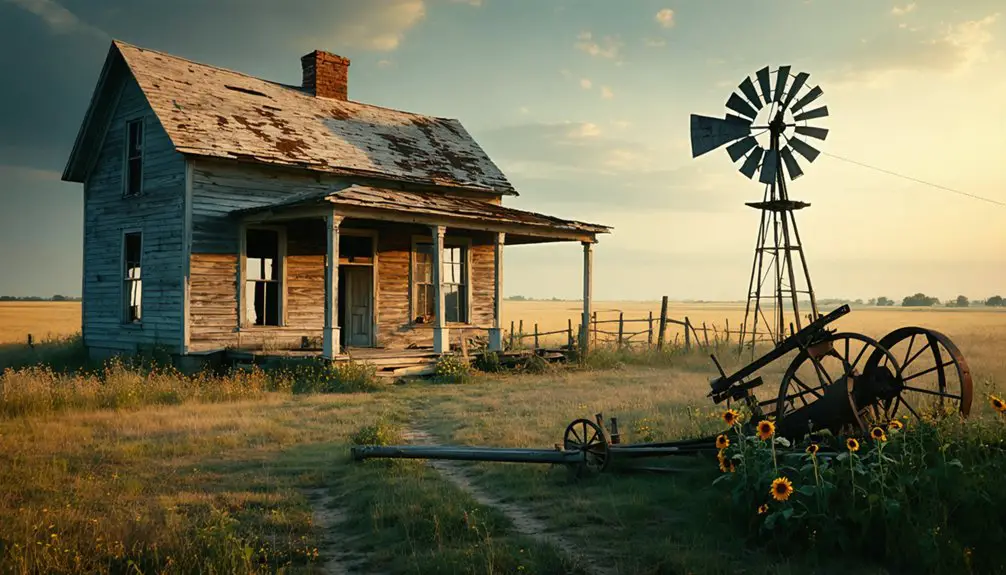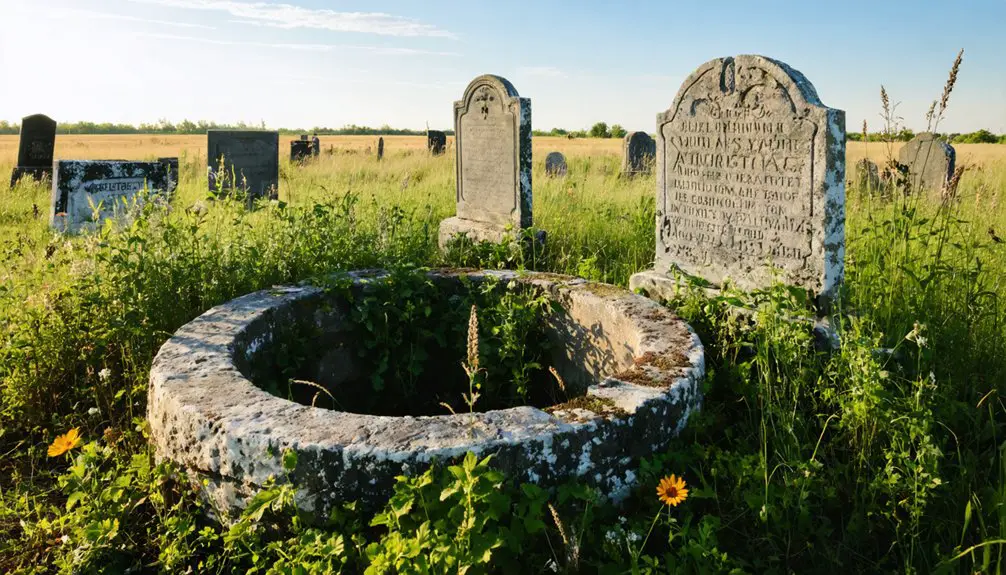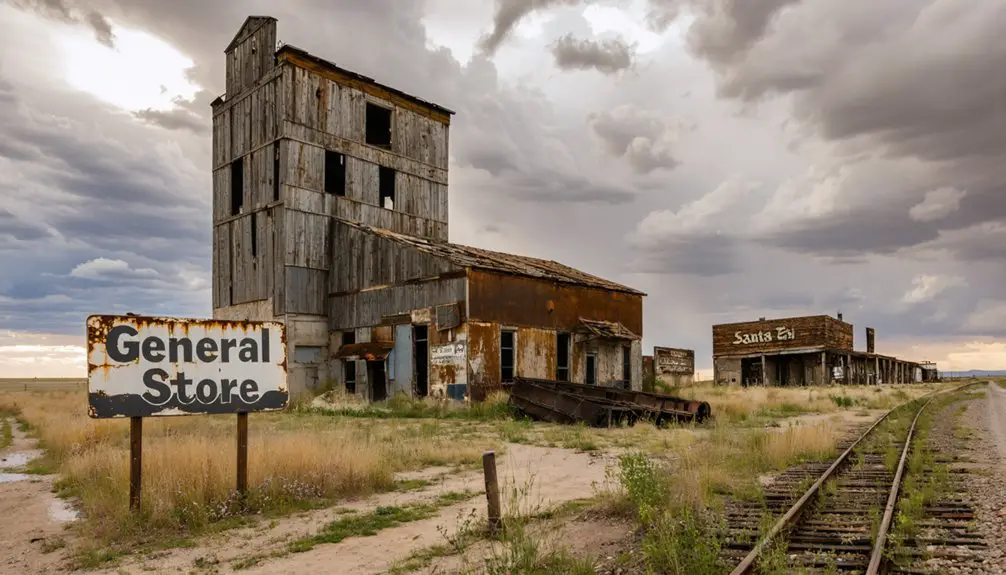You’ll find Williamsport, Kansas, as a ghost town that began with Rev. Robert Simerwell’s settlement in 1854. The township flourished with blacksmith shops, coal mines, and ferry service across the Shunganunga River. During the Bleeding Kansas period (1854-1859), violent conflicts between pro and anti-slavery factions disrupted daily life. By 1903, the post office’s closure marked the community’s decline. The stories of Williamsport’s pioneer families and economic struggles reveal deeper truths about America’s frontier experience.
Key Takeaways
- Williamsport Township was established in 1854 by Rev. Robert Simerwell, who built the first cabin and blacksmith shop in the area.
- The settlement struggled during the Bleeding Kansas period (1854-1859), with violent conflicts between pro-slavery and anti-slavery factions.
- The town’s decline accelerated after its post office closed in 1903, leading to community isolation and economic stagnation.
- Agricultural mechanization and dependence on single industries, particularly U.S. Rubber Company, contributed to the town’s economic downfall.
- The town’s legacy is preserved through oral histories, cemetery documentation, and local archive collections at Blue Rapids Museum.
The Pioneer Days: Rev. Robert Simerwell’s Settlement
When Rev. Robert Simerwell established Williamsport Township on August 13, 1854, he’d already spent decades pursuing Simerwell’s Mission among Native American communities.
You can trace his pioneer legacy back to his arrival from Ireland in 1803, where he learned blacksmithing before dedicating his life to Baptist missionary work.
After relocating from the Baptist Mission, he built the township’s first cabin and blacksmith shop in fall 1854.
With skilled hands from his blacksmithing trade, Simerwell constructed the cornerstone buildings that would define early Williamsport.
You’ll find his influence throughout early Williamsport’s development – from hosting the first Baptist sermon in his cabin that December to teaching at Indian schools with his daughter Sarah.
Through his marriage to a Shawnee woman and his translation of the New Covenant into Potawatomi, Simerwell bridged cultural divides until his death in 1868, leaving a lasting impact on both settler and indigenous communities.
The first local school was constructed through community subscription in 1857, furthering education in the growing settlement.
After his death, Joseph Drenan arrived on August 14 to help establish the growing settlement.
Early Infrastructure and Community Development
As Williamsport emerged from its pioneer roots in the 1850s, you’d find a rapidly developing infrastructure that transformed the settlement into a thriving community.
You could witness the commercial evolution through bustling coal mines producing 25 tons daily, alongside drug stores, grocery shops, and mills that served your daily needs.
The town’s community resilience shone through its response to multiple devastating fires. While wooden structures burned, stone buildings like the D. Fogle store stood firm.
You’d appreciate the convenience of the ferry service across the Shunganunga River, carrying three wagons at a time, while blacksmiths kept your transportation moving.
The town experienced significant growth by 1870, with essential infrastructure including a school, homes, and church serving the community’s needs.
Like many prairie towns of Kansas, the community spirit remained strong until the Great Depression triggered its eventual decline.
The Impact of Bleeding Kansas
During the tumultuous period of Bleeding Kansas (1854-1859), you’d find Williamsport caught in the crossfire of pro-slavery and anti-slavery factions battling for territorial control.
Tensions erupted in Williamsport as pro-slavery and anti-slavery forces clashed during Bleeding Kansas, turning the settlement into a battleground.
As social divisions deepened, early settlers like Rev. Robert Simerwell and Joseph Drenan faced constant uncertainty and violence that disrupted daily life. Regional conflicts created an atmosphere of suspicion, with communities taking up arms against neighboring rivals. Like the free state settlement of Barrett, many towns had to establish strong defensive positions during this volatile period.
You’ll notice how these tensions severely impacted Williamsport’s growth. The ongoing strife discouraged new settlers, hindered economic development, and delayed vital infrastructure projects. Much like the bitter rivalry between Springfield and Fargo Springs, neighboring settlements often found themselves in hostile confrontations over resources and political influence.
When railroads chose safer routes through other towns, Williamsport’s fate was fundamentally sealed. The lasting effects of these disruptions would eventually contribute to the settlement’s decline into a ghost town.
Daily Life in 1850s Williamsport
If you’d visited Williamsport in the 1850s, you’d have found settlers gathering at William Vaughan’s store for wool garments and essential supplies while sharing news from the mail routes.
You’d have witnessed the community’s reliance on T.N. Stinson’s ferry crossing for trade and transportation, and the constant activity at Rev. Simerwell’s blacksmith shop where tools were forged and repaired. The area’s rich soil composition of dark loam soil provided ideal conditions for growing small grains that sustained the settlement.
The social fabric of pioneer life was woven through shared experiences at religious services, where Rev. Gilpatrick and Rev. Stateler preached to congregations before permanent churches were built. During December 1855, residents endured one of the territory’s most severe winters, requiring them to bundle up in multiple layers of wool clothing while conducting their daily activities.
Pioneer Living Conditions
Life in 1850s Williamsport tested the resilience of pioneer families who faced harsh living conditions with limited resources.
You’d find pioneer shelters consisting of basic log cabins with cloth doors and dirt floors, offering little protection against brutal Kansas winters. If you’d visited these homes, you’d have seen families huddled around open fireplaces, their only source of heat and cooking.
Nutrition challenges plagued the community as they relied heavily on cornbread and bacon, supplemented by whatever wild game they could hunt. The arrival of emigrant aid companies helped establish sawmills and other infrastructure that gradually improved living conditions. With neighbors often miles apart, securing help during emergencies proved extremely difficult.
When crops failed during the devastating drought of 1859-1860, you couldn’t simply import food from the East – the transportation costs were too high.
Medical care was virtually nonexistent, forcing you to treat illnesses yourself. The primitive trails connecting settlements often became impassable, leaving you isolated during harsh weather.
Trading and Social Activities
How did settlers maintain connections in frontier Kansas? In 1850s Williamsport, trading posts weren’t just places to exchange goods – they were the heartbeat of community life.
You’d find settlers gathering daily at these bustling hubs, sharing news and forging bonds while conducting essential business.
Your social world revolved around these crucial community gatherings:
- Weekly market days at general stores where you’d trade goods and stories
- Regular visits to the blacksmith shop, doubling as a social center for latest news
- Trading post meetings where settlers and Native Americans exchanged supplies
- Community forums at stores that doubled as post offices
These commercial spaces, positioned near key transportation routes like the Ft. Leavenworth & Ft. Riley Road, kept Williamsport’s pioneers connected to both local happenings and the wider frontier world.
The Decline and Abandonment

Williamsport’s economic struggles intensified in the early 1900s as agricultural mechanization reduced local employment and the town’s commercial activity dwindled.
You’ll find that the Border War violence of the 1850s had already weakened the community’s foundation, destroying property and displacing early settlers from the region.
The final blow came when the post office closed its doors in 1903, effectively cutting off Williamsport’s crucial communication lifeline and accelerating the exodus of remaining residents.
Economic Hardships Strike Town
As agricultural profits dwindled in the mid-20th century, Williamsport faced mounting economic pressures that would ultimately seal its fate.
The rise of agricultural mechanization meant fewer farm workers were needed, triggering economic migration away from the community. You’d have witnessed the town’s liveliness fade as remaining residents struggled to maintain their way of life.
The cascading effects of this decline manifested in four critical ways:
- Family farms consolidated into larger operations, eliminating jobs
- Local businesses shuttered as customer bases shrank
- Tax revenues plummeted, crippling essential services
- Young families left for urban areas with better opportunities
Without its agricultural foundation, Williamsport couldn’t sustain its economic base.
The exodus of working-age residents created a downward spiral that would transform this once-vibrant farming community into a ghost town.
Border War Violence Impact
The violent Border War of 1854-1858 brought devastating instability to Williamsport long before its agricultural decline.
Border conflicts between proslavery Missouri ruffians and free-state Kansas settlers created an atmosphere of terror that tore at the community’s fabric. You’d have seen fortified homes with gun loops, as residents anticipated raids from across the state line.
Settlement challenges became insurmountable as Missouri-based militias conducted armed incursions, burning buildings and threatening settlers. The attacks forced many to flee, leaving stretches of border territory nearly abandoned.
Despite attempts at peace talks, including the 1858 governor’s meeting, violence persisted. With federal authorities largely absent and Missouri officials actively supporting raids, Williamsport’s residents faced constant threats that ultimately contributed to the town’s demise.
Post Office Closure Effects
When the Williamsport post office closed its doors in the late 1800s, you’d have witnessed the heart of the community stop beating.
This essential hub of communication and commerce became another empty building, triggering a cascade of devastating effects that would seal the town’s fate.
The closure’s impact rippled through Williamsport in four critical ways:
- Community isolation deepened as residents lost their central gathering place.
- Local businesses suffered from disrupted mail services and reduced trade.
- Property values plummeted, deterring new investment and development.
- Economic stagnation set in as the town lost connectivity to broader markets.
You’d have seen families gradually moving away, seeking towns with better services.
The once-bustling streets grew quiet, and remaining buildings fell into disrepair, marking Williamsport’s change into a ghost town.
What Remains Today: Cemetery and Well

Today’s visitors to Williamsport, Kansas will find only a modest cemetery marking the ghost town‘s former location, with most gravestones dating back to the late 1800s.
Many headstones lie buried or toppled, though occasional cemetery restoration efforts by descendants and local enthusiasts have repaired some using construction adhesive and steel posts.
If you’re interested in ghost town tourism, you’ll need to navigate through buffalo grass and natural overgrowth to locate the graves. The cemetery serves as the last physical connection to Williamsport’s past, attracting genealogists and historians researching family histories.
While some Kansas ghost towns boast supernatural legends, Williamsport’s cemetery remains a quiet memorial to the early settlers who once called this place home.
The surrounding wildlife refuges have reclaimed much of the land, leaving this humble graveyard as the sole witness to the town’s existence.
Notable Residents and Their Stories
Pioneer spirit came alive in Williamsport through its earliest settlers, particularly Rev. Robert Simerwell, who built the town’s first cabin and blacksmith shop in 1854.
You’ll find these influential figures shaped the community’s foundation:
- William Simerwell carried on his father’s legacy after 1868, maintaining the family farm that marked the town’s beginnings.
- Joseph Drenan established his homestead northeast of town in August 1854, paving the way for future settlers.
- W.B. Stith constructed the only house on Williamsport’s original townsite, marking a significant pioneer milestone.
- Local heroes Stinson, Whitehead, and McDonald demonstrated true frontier compassion by aiding families during a devastating disease outbreak that claimed several lives, including Dr. Gallimore and his wife.
Economic Forces Behind the Ghost Town

Like many single-industry towns of its era, Williamsport’s economic story reads as a classic boom-and-bust tale centered around manufacturing.
You’ll find a community that thrived during World War I, producing essential goods like motors, shoes, and cables. By 1929, industrial dependency peaked with 54% of residents working in manufacturing, riding high on the 1920s prosperity wave that saw the population grow by 20%.
But when the U.S. Rubber Company shuttered its doors in 1928, laying off 1,100 workers, it exposed Williamsport’s lack of economic resilience.
The Great Depression delivered the final blow, triggering an exodus of workers and their families. Without diverse industries to cushion the fall, the town’s fate was sealed – another reminder that communities built on single industries often struggle to survive economic upheavals.
Comparing Williamsport to Other Kansas Ghost Towns
When comparing Williamsport to other Kansas ghost towns, you’ll find its story uniquely reflects the smaller, pioneer-era settlements rather than the larger industrial boom towns.
While towns like Barrett and Irving peaked at around 200 residents, Williamsport remained more modest in size, maintaining its early territorial character.
Key ghost town characteristics that set Williamsport apart from its counterparts:
Williamsport’s unique ghost town qualities showcase how distinct circumstances shaped the fates of Kansas’ forgotten frontier settlements.
- Agricultural roots rather than industrial foundations, unlike Barrett’s limestone quarries
- Limited structural remains compared to larger abandoned towns’ infrastructure
- Earlier establishment during pioneer settlement, predating the railroad boom era
- Typical rural depopulation pattern caused by farming mechanization, similar to Woods and Springfield
These Williamsport comparisons reveal how transportation shifts and economic changes shaped the destinies of Kansas’ lost communities differently.
Preserving the Memory: Historical Records and Research
You’ll find the richest sources of Williamsport’s history in the meticulous cemetery records and burial documentation maintained by Marshall County historical societies since 1857.
The Blue Rapids Museum’s local archive collection houses essential photographs, land records, and manuscripts that tell the story of Williamsport’s rise and decline through firsthand accounts.
Through ongoing oral history projects, you can access recorded memories from descendants of original settlers, including the Simerwell and Drenan families, who’ve shared their ancestors’ experiences of life in this Kansas ghost town.
Cemetery Documentation Efforts
The preservation of Williamsport’s cemetery records stands as a tribute to dedicated local historians and genealogists who’ve meticulously documented the site’s historical significance.
Through careful tombstone transcriptions and grave marker preservation efforts, you’ll find detailed documentation that safeguards the community’s historical legacy for future generations.
You can access the cemetery’s essential information through:
- Carbon-copied transcriptions detailing names, dates, and epitaphs
- Searchable online databases on platforms like FamilySearch and Interment.net
- Mapped grid patterns showing grave locations, including unmarked burial sites
- Digital photographs preserving inscriptions before physical decay
Community volunteers continue their crucial work documenting these records, ensuring you can trace your family history even as the physical cemetery faces environmental challenges in this historic ghost town.
Local Archive Collections
Beyond the cemetery’s physical boundaries, rich archival collections preserve Williamsport’s complete historical narrative.
You’ll find detailed records at the Blue Rapids Museum, where photographs and displays chronicle the ghost town’s connection to Marshall County’s early settlement patterns. The Riley County Genealogical Society maintains extensive documentation of Kansas ghost towns, including essential records of Williamsport’s pioneering families.
Local archives house critical primary sources from 1857 onward, including town company organization papers, land records, and homestead claims.
The Kansas Collection features settler biographies and town development notes, while U.S. General Land Office records reveal property ownership patterns.
Through FamilySearch and Bureau of Land Management databases, you can trace Williamsport’s evolution from a hopeful settlement to its eventual decline.
Oral History Preservation
Since preserving Williamsport’s living history became vital in the 1970s, local historians have implemented thorough oral history preservation methods to safeguard community memories.
You’ll find these preservation challenges have been met with careful attention to detail and modern archival standards.
The local historical society maintains these significant recordings through:
- Storage of original magnetic tapes in temperature-controlled environments (10-21°C)
- Creation of acid-free paper transcripts housed in archival-quality boxes
- Digital conversion of recordings to non-proprietary formats with multiple backup copies
- Regular integrity checks and migration of digital files to prevent data loss
These methods guarantee that your community’s oral history remains accessible for future generations, preserving the authentic voices and stories of Williamsport’s former residents.
Frequently Asked Questions
Were There Any Documented Supernatural Occurrences or Ghost Stories in Williamsport?
You won’t find any documented supernatural sightings or ghostly legends here. Despite the town’s Civil War destruction, thorough research shows no paranormal tales have survived through local history or folklore.
What Was the Maximum Population of Williamsport During Its Peak?
Like a fading photograph, you won’t find exact peak numbers, but considering historical significance and population decline patterns, your best estimate would be fewer than 500 residents during the late 1800s.
Did Any Famous Outlaws or Gunfighters Ever Pass Through Williamsport?
You won’t find any documented outlaw sightings or gunfighter legends here – historical records show no famous desperados visited. The town’s peaceful settlement focused on community building rather than Wild West drama.
What Native American Tribes Originally Inhabited the Williamsport Area?
Like ancient footprints in time, the Shawnee tribe primarily inhabited your area’s lands in the 1820s-1830s, while the Kanza people previously lived along the Kansas River valley with deep cultural significance.
Were There Any Major Natural Disasters That Affected Williamsport?
You won’t find records of any major natural events directly impacting the community. While the region faced typical prairie storms and droughts, it was actually the railroad bypass that sealed the town’s fate.
References
- https://www.youtube.com/watch?v=8imf9ZEYVSA
- https://www.youtube.com/watch?v=iB5rHT14eVI
- https://stephentravels.com/top5/ghost-towns/
- https://www.kancoll.org/books/cutler/shawnee/shawnee-co-p2.html
- https://legendsofkansas.com/kansas-ghost-town-list/
- http://www.ksgenweb.org/archives/1878/shawnee.html
- https://www.shawneecountyhistory.org/history
- https://www.kancoll.org/books/cutler/shawnee/shawnee-co-p49.html
- https://legendsofkansas.com/robert-simmerwell/
- https://dianastaresinicdeane.wordpress.com/2011/12/23/o-little-town-of-williamsburg/



